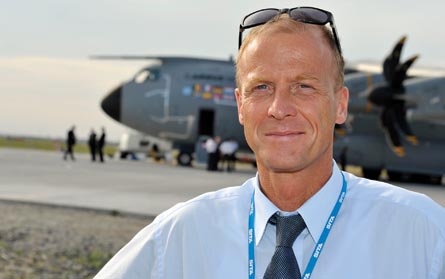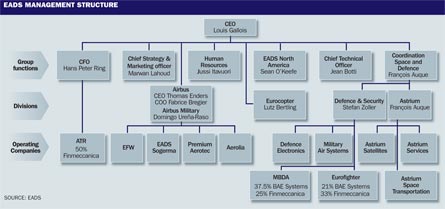For much of its existence, the citizenship of EADS's senior managers appeared as important as their ability to do a job. The first years of the company saw EADS run by two chairmen and two chief executives (in each case, one nominated by each of the main shareholders) with layers of senior management under them where Frenchman tended to report to German and vice versa.
Although amiable relationships between the individuals at the top meant this carefully constructed balance of power worked reasonably well, more dysfunctional was an organisation in which national loyalties and working cultures were sometimes in conflict with the multinational business divisions within EADS.
|
|---|
COMMUNICATIONS BREAKDOWN
At best this led to breakdowns in communication and internal tussles for workshare and resources, where country managers enlisted the backing of their politicians. At worst, it created deep suspicions and an inability to co-operate for a common interest.
It came to a crunch in the middle of the decade when a crisis emerged at Airbus, EADS's biggest division. Progress on the hugely ambitious A380 programme was halted when it turned out that engineers at the two centres managing different sections of the fuselage - Toulouse and Hamburg - could not reconcile the kilometres of wiring connecting the various systems. It seemed to symbolise the crippling cross-Rhine divide between the two main branches of Airbus. Coupled with a scandal over alleged illegal share-selling by senior managers, the crisis led to the resignation of Airbus chief executive Noel Forgeard, who had harboured ambitions to run the whole of EADS.
After a short-lived attempt to bring in an outsider, Christian Streiff, to run Airbus and to replace founding co-chief executives Philippe Camus and Rainer Hertrich with another Franco-German partnership - Louis Gallois and Tom Enders - EADS opted for a conventional management structure that to most outsiders seemed to make sense. In 2007, Gallois became sole chief executive, with former defence division chief Enders reporting to him as head of Airbus, a job he says he always wanted to do. A single chairman replaced the two chairmen nominated by French and German shareholders.
A further shake-up saw a new generation of EADS's brightest younger executives who had made their names as part of the integrated company move into more senior roles. They included Fabrice Bregier, who became number two at Airbus with Lutz Bertling replacing him at Eurocopter; Marwan Lahoud, who moved from MBDA to become head of strategy and marketing, Domingo Urena Raso, who took on the new Airbus Military and Stefan Zoller, who assumed the reins at Defence and Security.
The divisional structure and reporting lines - which had as much to do with politics as management efficiency - were also tidied up. The former Spanish-based Military Transport division was integrated into Airbus, which also became directly responsible for the troubled A400M programme. An Aerosystems division had already been wound up in the middle of the decade, leaving just four divisional heads (Francois Auque is ultimately responsible for Space and Defence & Security), four "functional" chief officers (human resources, technology, strategy/marketing and finance) and North America chief Sean O'Keefe reporting to Gallois (see chart).
DIFFICULTIES
"It has not always been easy," Gallois admitted in an interview for this EADS 10th anniversary special in June. "We had difficulties with governance, with two chief executives, two chairmen and a split board. We had to change it in 2007 after the A380 crisis. It was a lesson learned."
Outside circumstances - a high dollar which boosted revenues and troubles at Boeing over the failed Sonic Cruiser programme - masked EADS's internal problems in the early years, says Gallois. It was a period when Airbus was overtaking its rival on orders and deliveries, particularly with its highly successful narrowbody range, and basking in the publicity of its A380 and A400M launches.
"But it was a bit fragile because we were not an integrated company," he says. "The A380 and A400M demonstrated that we were not managing problems in an integrated way."
For the first time EADS appears to have a succession plan that may not involve the sort of internecine strife that followed the passing of a childless medieval monarch.
Enders remains favourite to eventually replace the 66-year-old Gallois, whose current term expires in 2012, with Bregier tipped to be the next Airbus boss, although Lahoud is also known to harbour big ambitions and there is an outside chance that EADS's board might opt for an outsider to fill either or both roles, although the Streiff experience makes this less likely.
What is clear, however, is that candidates will be selected on merit rather than nationality. "We have changed our governance," says Gallois. "The emphasis is now on business and no longer on politics between France and Germany."
Source: Flight International





















